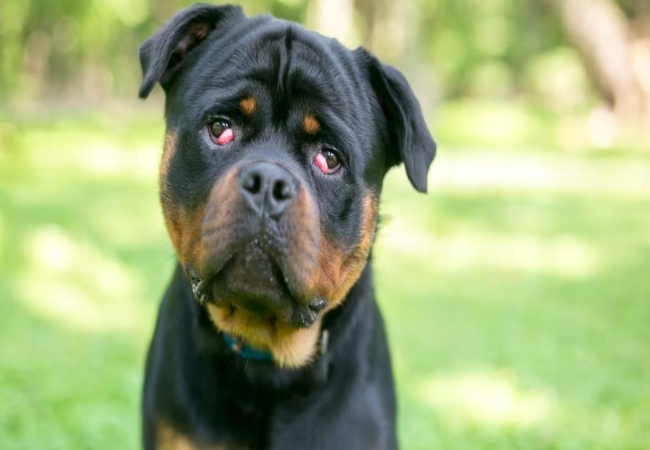Veterinary Guide to Prolapsed Third Eyelid Gland (“Cherry Eye”) in 2025 🐶

In this article
Veterinary Guide to Prolapsed Third Eyelid Gland (“Cherry Eye”) in 2025 🐶
By Dr. Duncan Houston BVSc
🔍 Introduction
Cherry eye refers to the prolapse of the third eyelid gland in dogs, causing a visible pink-red mass at the inner eye corner. Although not incredibly painful, it puts the gland at risk of trauma, infection, and long-term tear production loss. This 2025 guide covers everything you need to know: causes, signs, diagnosis, surgical repair, complications, and preventive strategies. 🩺
💡 What Is It?
- Prolapse occurs when the ligament anchoring the nictitating membrane gland weakens or detaches, causing the gland to protrude—often looking like a cherry in the medial canthus.
- Typically affects dogs younger than two years, and often occurs intermittently before becoming permanent.
⚠️ Causes & Risk Factors
- Breed predisposition—brachycephalic and herding breeds: Bulldogs, Beagles, Cocker Spaniels, Neapolitan Mastiffs, Rottweilers, etc..
- Genetic component—studies show defective retinaculum anchorage, more common in certain breeds.
- May follow eye irritation or inflammation, but often occurs spontaneously.
🚨 Clinical Signs
- Soft, red or pink mass in inner corner of eye (“cherry pit”).
- Intermittent protrusion that may become permanent with swelling.
- Signs of ocular irritation: tearing, conjunctivitis, mucoid discharge, or pawing.
🔬 Diagnosis
- Visual recognition is often sufficient; confirm with a full ophthalmic exam: staining, intraocular pressure, tear test.
- Evaluate tear production—critical given gland’s important role in tear film.
- Check for corneal damage (fluorescein stain) or infection due to protrusion and rubbing.
🛠 Treatment: Surgical Gland Replacement
- Gland replacement is strongly preferred over removal to preserve tear production and prevent dry eye (keratoconjunctivitis sicca).
- “Pocket” (envelope) technique is most common—creates a conjunctival pouch anchoring the gland.
- Posterior suturing methods have high success and low complication rates.
🔄 Post‑Operative Care & Prognosis
- Apply antibiotic and anti-inflammatory eye drops/ointments for 1–2 weeks post-op.
- Use e-collar to prevent rubbing. Avoid water exposure and play for 10–14 days.
- Success rate is high (>90%). However, re-prolapse occurs in ~5–20%, especially in Bulldogs, Mastiffs, Boxers—may require revision surgery.
📈 Complications if Untreated
- Conjunctivitis, dry eye, and corneal ulcers from exposure and reduced tear production.
- Chronic gland prolapse may cause gland atrophy; removal then becomes more likely.
- Dry eye may require lifelong artificial tears if gland function is lost.
🛡 Prevention & Breeding Advice
- Early veterinary check—before 2 years old—for predisposed breeds.
- Minimize eye trauma and chronic irritation (keep facial folds clean in brachycephalic dogs).
- Breeders should avoid breeding affected dogs, even post-surgery.
🔧 Tools & Support Services
- Ask A Vet App: 24/7 advice for recognition, urgency, pre/post-op care, and tear management 📱
✅ Final Thoughts
Cherry eye is a treatable but potentially complex ocular condition. Early diagnosis and gland-preserving surgery typically lead to excellent outcomes. Complications like dry eye can be minimized, and recurrence managed with timely revision. With tools like Ask AVet, dogs can maintain healthy vision and comfort. 🐾❤️
Download the Ask A Vet app today for expert guidance on eye mass detection, surgical planning, and long-term tear support. 📱💡






